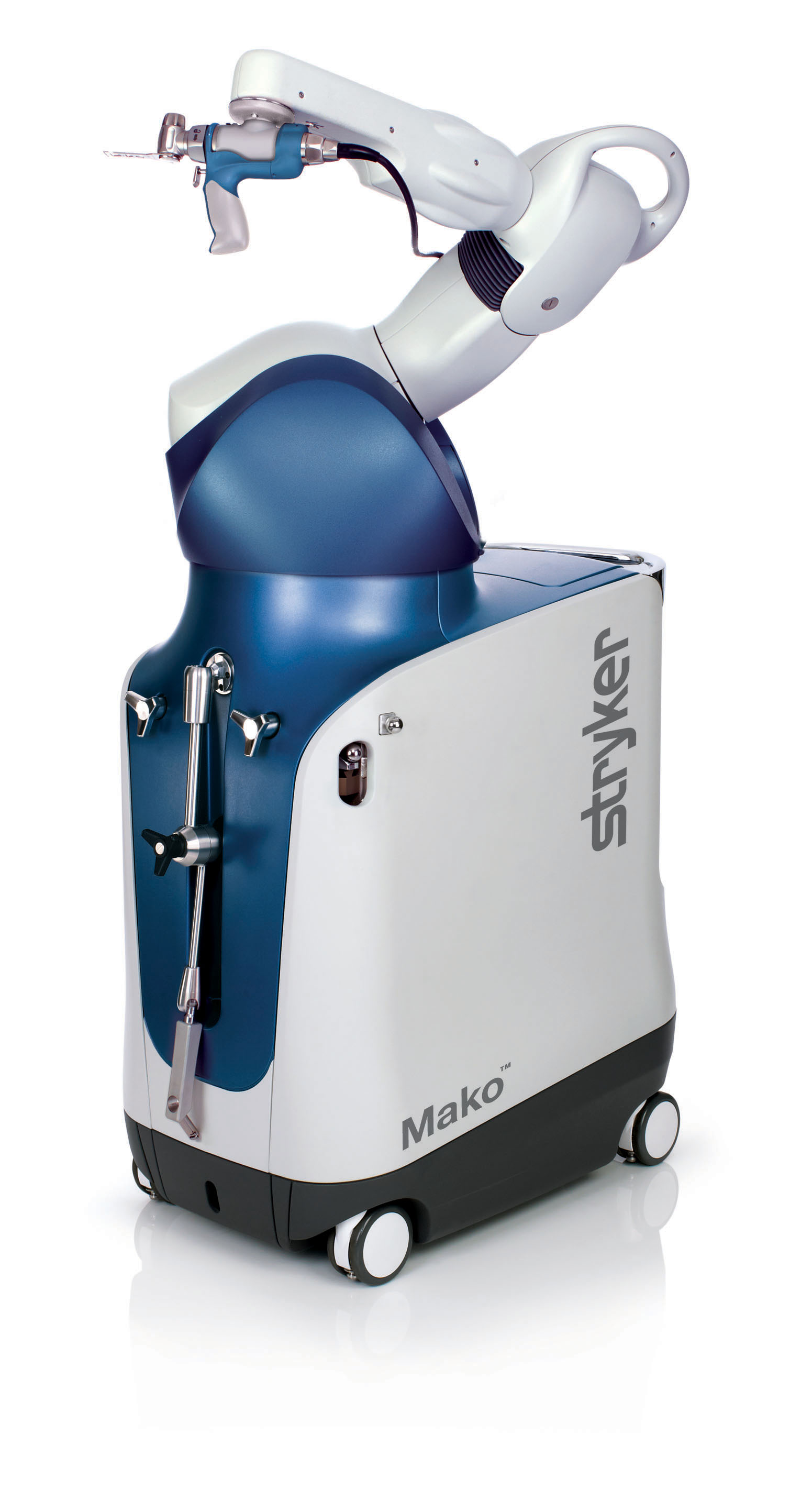Osteoarthritis of the Knee and Mako SmartRobotics™
Keeping You On the Move
Osteoarthritis (OA) is a form of arthritis and a degenerative joint disease characterized by the breakdown and eventual loss of joint cartilage. Cartilage is a protein substance that serves as a cushion between the bones of a joint. With OA, the top layer of cartilage breaks down and wears away, allowing bones under the cartilage to rub together.
At Orthopedic Associates, our joint replacement experts proudly perform advanced Mako SmartRobotics joint replacements to treat osteoarthritis of the knee.
What causes OA of the knee?
Although the root cause of OA is unknown, the risk of developing symptomatic OA is influenced by multiple factors such as age, gender, and inherited traits that can affect the shape and stability of your joints.
Other factors can include:
- A previous knee injury
- Repetitive strain on the knee
- Improper joint alignment
- Being overweight
- Exercise or sports-generated stress placed on the knee joints
What are the symptoms of OA of the knee?
Symptoms of OA of the knee include:
- Pain while standing or walking short distances, climbing up or down stairs, or getting in and out of chairs
- Knee pain with activity
- Start-up pain or stiffness when activities are initiated from a sitting position
- Stiffness in your knee joint after getting out of bed
- Swelling in one or more areas of the knee
- A grating sensation or crunching feeling when you use your knee
How is OA of the knee diagnosed?
Your physician will begin by reviewing your medical history and symptoms. He or she will observe the natural movement of your knee, evaluate your knee and ankle joint alignment, and check your reflexes, muscle strength, range of motion, and ligament stability in the affected knee. Your physician may order X-rays to determine how much joint or bone damage has been done, how much cartilage has been lost, and if there are bone spurs present.
Additional medical imaging tests, such as computed tomography (CT) or magnetic resonance imaging (MRI), may be ordered to determine exactly where the damage is and its extent. Your physician may also order blood tests to rule out other causes of symptoms or order a joint aspiration, which involves drawing fluid from the joint through a needle and examining the fluid under a microscope.
How is OA treated?
Whether your OA is mild or severe, your physician will most likely recommend certain lifestyle changes to reduce stress on your knee joints. Additional disease and pain management strategies may include: physical therapy, steroid injections, over-the-counter pain medications such as acetaminophen, nonsteroidal anti-inflammatory drugs (NSAIDs), or topical pain relieving creams.
Please speak with your physician if your symptoms aren’t responding to nonsurgical solutions, or your pain can no longer be controlled by medication. You could be a candidate for surgery.
The most common surgical knee intervention performed for OA is a total knee replacement. During this procedure, the natural joint is removed and replaced with an artificial implant. This treatment option is usually offered to patients with advanced osteoarthritis of the knee.
What is Mako SmartRobotics?
Mako SmartRobotics is an innovative treatment option for adults living with early to mid-stage OA in the medial (inner), patellofemoral (top), or lateral (outer) compartments of the knee.

During the procedure, the diseased portion of the knee is resurfaced, sparing the patient’s healthy bone and surrounding tissue. An implant is then secured in the joint to allow the knee to move smoothly again.
The Mako System can:
- Facilitate optimal implant positioning to result in a more natural feeling knee following surgery
- Result in a more rapid recovery and shorter hospital stay than traditional knee replacement surgery
- Be performed on an outpatient basis
- Promote a rapid relief from pain and return to daily activities
As a knee arthroplasty procedure, Mako is typically covered by most Medicare-approved and private health insurers.
How may Mako SmartRobotics benefit me?
Mako SmartRobotics is designed to relieve the pain caused by joint degeneration and potentially offers the following benefits:
- Patient-specific surgical plan with preoperative CT scan to develop a 3D virtual model of the involved joint
- Improved accuracy and precision of bone cuts and implant positioning compared to traditional total and partial knee replacements
- More predictable limb alignment compared to traditional knee replacements
- Improved soft tissue balance
- Haptic guidance and safety boundaries reduce the risk of inadvertent soft tissue and ligament damage
- Lower pain scores and better patient satisfaction 6 months after surgery compared to traditional joint replacements
How does Mako SmartRobotics work?
The Mako System features 3D presurgical planning.
During surgery, Mako provides the surgeon with real-time visual, tactile, and auditory feedback to facilitate optimal joint resurfacing and implant positioning. It is this optimal placement that can result in more natural knee motion following surgery.
Who would be a good candidate for the Mako procedure?
Typically, Mako patients share the following characteristics:
- Knee pain with activity, usually on the inner knee and/or under the kneecap, or the outer knee
- Start-up knee pain or stiffness when activities are initiated from a sitting position
- Failure to respond to nonsurgical treatments or nonsteroidal anti-inflammatory medication
If I undergo Mako SmartRobotics surgery, what can I expect?
The Mako System can be used in an inpatient procedure or on an outpatient basis depending on what your orthopedic surgeon determines is right for you. Hospital stays average anywhere from one to three days; ambulatory patients return home the same day.
In many cases, patients are permitted to walk soon after surgery, drive a car within two weeks, and return to normal daily activities shortly thereafter.
What is the lifespan of a Mako implant?
All implants have a life expectancy that depends on several factors, including the patient’s weight, activity level, quality of bone stock, and compliance with their physician’s orders.
Proper implant alignment and precise positioning during surgery are also very important factors that can improve the life expectancy of an implant. Through the use of Mako SmartRobotics, implants can be optimally aligned and positioned to ensure the longest benefit.
*Individual results may vary. There are risks associated with any knee surgical procedure, including Mako. Your doctor can explain these risks and help determine if Mako SmartRobotics is right for you.
Why choose Orthopedic Associates?
Our specialty-trained Mako experts at Orthopedic Associates are highly experienced in performing Mako SmartRobotics joint replacements. With their additional training in joint replacement, they have the experience and expertise to assess, diagnose, and treat your joint replacement condition individually to your needs.
To consult with one of our doctors at Orthopedic Associates of Port Huron, please call (810) 985-4900 or schedule an appointment online.



